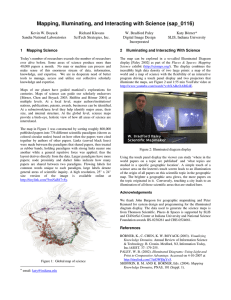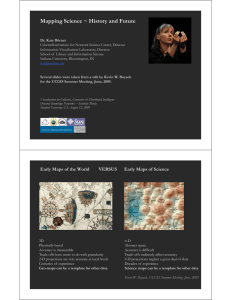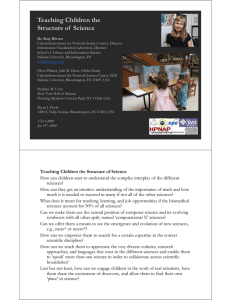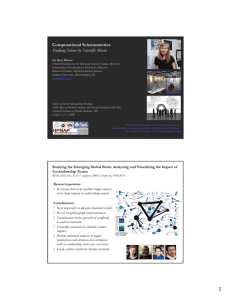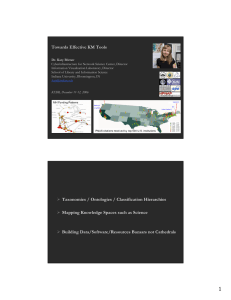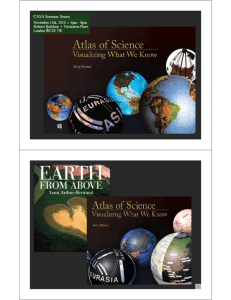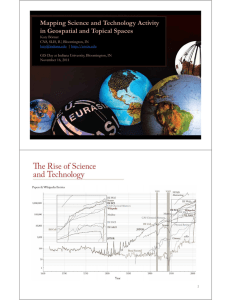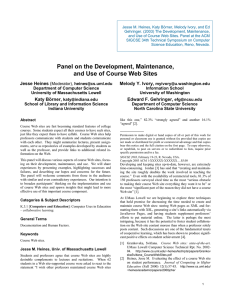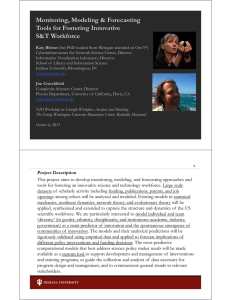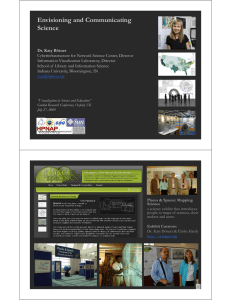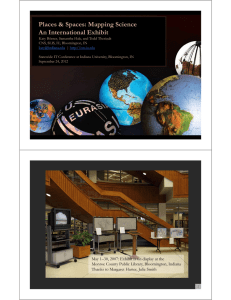Towards a Science of Science (Policy)
advertisement
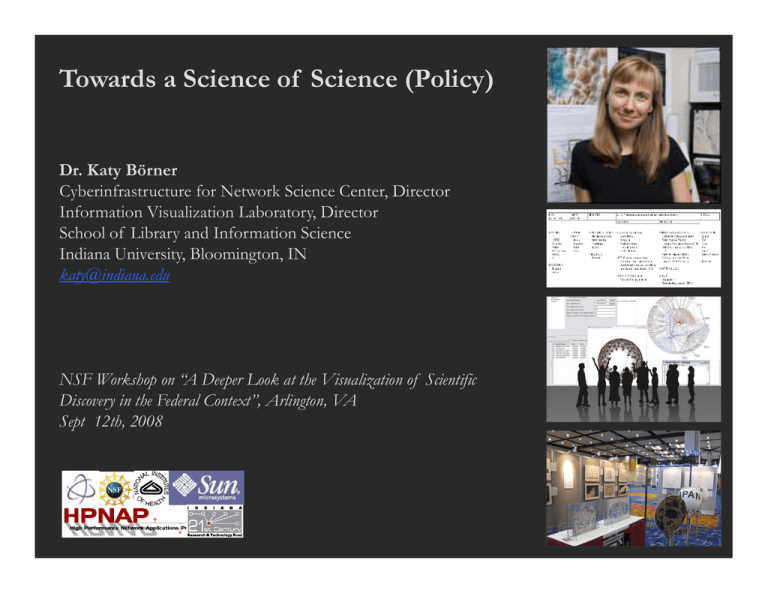
Towards a Science of Science (Policy) Dr. Katy Börner Cyberinfrastructure for Network Science Center, Director Information Visualization Laboratory, Director School of Library and Information Science Indiana University, Bloomington, IN katy@indiana.edu NSF Workshop on “A Deeper Look at the Visualization of Scientific Discoveryy in the Federal Context”, Arlington, g VA Sept 12th, 2008 Overview 1 1. F t Features off Science S i 2. 3. 4. 5. 6. Detailed Needs Analysis Conceptualization of Science / Terms & Definitions Data Quality, Coverage and Interlinkage Algorithms g and Cyberinfrastructures y Case Studies and Evaluation 7 7. St d d and Standards dP Practices ti 8. Dissemination of Results 1. Features of Science E. O. Wilson in Consilience: The Unity of Knowledge (1998) writes: “F t “Features that th t distinguish di ti i h science i from f pseudoscience p d i are repeatability, p t bilit economy, menuration, ti heuristics, and consilience.” For a true science of science (policy) this can be detailed as: Repeatability refers to the fact that any science analysis, model, or map can be rerun or regenerated by a scholar other than the author. This requires that datasets are accessible and documented in a way that they can be recompiled, software is made available or is doc mented in sufficient documented s fficient detail so that it can be reimplemented and run r n with the exact same parameter settings. Economy entails that results are presented in a form that is both simplest and most pleasing not only for the expert but also for a general audience. Mensuration means properly measured, using universally accepted scales in an unambiguous fashion. Heuristics – the best science stimulates further discovery. Consilience – those explanations and results that are consistent with each other are most likely to survive. 2. Detailed Needs Analysis As part of TLS: Towards a Macroscope for Science Policy Decision Making. NSF SBE0738111 award (Katy Börner, Weixia Huang, Kevin W. Boyack). that aims to design g qualitatively q new tools for science policy p makers, we are conductingg interviews with science policy makers at different levels of the science enterprise to identify what 'science of science' research results and tools might be most beneficial. Each interview comprises a 40 min, audio audio-taped, taped, informal discussion on specific information needs, datasets and tools currently used, and information on what a 'dream tool' might look and feel like. There is also a pre-interview questionnaire to acquire demographics and a postinterview questionnaire to get your input on priorities. Results of 30+ interviews should become available at the end of 2008. But see also Paul Gemperline’s slides. 3. Conceptualization of Science / Terms & Definitions Identify ‘basic basic units’ units of science, their ‘interlinkages’, and major static and d dynamic i properties i off interest. Define (ideally operationalize) major terms such as impact, interdisciplinarity, etc. What conceptual description might best represent science? See also l SSpecial i l Issue I off Journal of Informetrics, 3(1), Jan 2009. Conceptualizing Science Hypothetical Model of the Evolution and Structure of Science, by Daniel Zeller O di On display l iin 33rdd iiteration i off exhibit. hibi Authors are mortal mortal. Papers are immortal immortal. Densely knit communities. The importance of weak links. Cumulative structure of science. The unknown is rendered as monster shaped voids. Impact of funding on science (yellow). 3. Conceptualization of Science / Terms & Definitions Process of Analyzing and Mapping Knowledge Domains Börner, Katy, Chen, Chaomei, and Boyack, Kevin. (2003) Visualizing Knowledge Domains. In Blaise Cronin (Ed.), Annual Review of Information Science & Technology, Volume 37, Medford, NJ: Information Today, Inc./American Society for Information Science and Technology, chapter 5, pp. 179-255. 4. Data Quality, Coverage and Interlinkage “F “From Data D t Silos Sil to t Wind Wi d Chimes” Chi ” Interlink creators, data, software/tools, publications, patents, IP, funding, etc. Create public databases that any scholar can use. Share the burden of data cleaning l and d federation. f d Scholarly Database: Web Interface Search across publications, patents, grants. Download records and/or / ((evolving) g) co-author,, paper-citation p p networks. Register for free access at https://sdb.slis.indiana.edu. Scholarly Database: # Records & Years Covered Datasets available via the Scholarly Database (* future feature) D t t Dataset # Records R d Y Years C Covered d U d t d Updated Restricted R t i t d Access Medline 13,149,741 1965-2005 Ph R PhysRev 398 005 398,005 1893 2006 1893-2006 Y Yes PNAS 16,167 1997-2002 Yes JCR 59,078 1974, 1979, 1984, 1989 1994-2004 Yes 3,179,930 1976-2004 Yes* NSF 174,835 1985-2003 Yes* NIH 1,043,804 1972-2002 Yes* USPTO Yes Total 18,021,560 1893-2006 4 Aim for comprehensive p time, ggeospatial, p and topic p coverage. g 3 Holdings of Scholarly Databases/Wikipedia, 1665 to 2006 #papers per publication year 5. Algorithms and Cyberinfrastructures http://nwb.slis.indiana.edu/ http://epic.slis.indiana.edu/ See https://nwb.slis.indiana.edu/community July 1st, 2008 6. Case Studies and Evaluation Desirable Features Theoretically grounded Practically relevant Testable T t bl hypotheses h th Well documented results Repeatable Types of Studies Individual, local, global level Temporal, geospatial, semantic, network analysis Result Presentation Textual, tabular, charts, geo maps, science maps, other reference systems Spatio-Temporal Information Production and Consumption of Major U.S. Research Institutions Börner, Katy, Penumarthy, Shashikant, Meiss, Mark and Ke, Weimao. (2006) M i the Mapping h Diffusion Diff i off Scholarly S h l l Knowledge K l d Among A Major M j U.S. U S Research R h Institutions. Scientometrics. 68(3), pp. 415-426. Research questions: 1 Does space still matter 1. in the Internet age? 2. Does one still have to j research studyy and work at major institutions in order to have access to high quality data and expertise and to produce high quality research? 3 Does 3. D the h Internet I lead l d to more global l b l citation i i patterns, i.e., more citation links between papers produced at geographically distant research instructions? Contributions: Answer to Qs 1 + 2 is YES. Answer to Qs 3 is NO. Novel N l approach h to analyzing l i the h dduall role l off institutions as information producers and consumers and to study and visualize the diffusion of information among them. Mapping the Evolution of Co-Authorship Networks Ke, Visvanath & Börner, (2004) Won 1st price at the IEEE InfoVis Contest. 16 17 Latest ‘Base Map’ of Science Kevin W. Boyack, Katy Börner, & Richard Klavans (2007). Mapping the Structure and Evolution of Ch i Research. Chemistry R h 11th 11 h International I i l Conference C f on Scientometrics Si i andd Informetrics. I f i pp. 112-123. 112 123 Uses combined SCI/SSCI from 2002 • 1.07M papers, 24.5M references, 7,300 journals • Bibliographic coupling of p p r aggregated papers, r t d tto journals Initial ordination and clustering of journals gave 671 clusters Coupling counts were reaggregated at the journal cluster level to calculate the • (x,y) positions for each journal cluster • by association, (x,y) positions ii for f each h jjournall Math Law Policy Computer Tech Statistics Economics Education CompSci Vision Phys-Chem Chemistry Physics Psychology Brain Environment Psychiatry GeoScience MRI Biology BioMaterials BioChem Microbiology Pl t Plant Cancer Animal Disease & Treatments Virology Infectious Diseases Science map applications: Identifying core competency Kevin W. Boyack, Katy Börner, & Richard Klavans (2007). Funding patterns of the US Department of Energy (DOE) Math Law Computer Tech Policy Statistics Economics CompSci Vision Education Phys-Chem Chemistry Physics Psychology Brain Environment Psychiatry GeoScience MRI Biology GI BioBi Materials BioChem Microbiology Plant Cancer Animal Virology Infectious Diseases Science map applications: Identifying core competency Kevin W. Boyack, Katy Börner, & Richard Klavans (2007). Funding Patterns of the National Science Foundation (NSF) Math Law Computer Tech Policy Statistics Economics CompSci Vision Education Phys-Chem Chemistry Physics Psychology Brain Environment Psychiatry GeoScience MRI Biology GI BioBi Materials BioChem Microbiology Plant Cancer Animal Virology Infectious Diseases Science map applications: Identifying core competency Kevin W. Boyack, Katy Börner, & Richard Klavans (2007). Funding Patterns of the National Institutes of Health (NIH) Math Law Computer Tech Policy Statistics Economics CompSci Vision Education Phys-Chem Chemistry Physics Psychology Brain Environment Psychiatry GeoScience MRI Biology GI BioBi Materials BioChem Microbiology Plant Cancer Animal Virology Infectious Diseases 7. Standards and Practices Which ones exist? Relevant Scholarly Reviews/Issues Börner,, Katy, y, Chen,, Chaomei,, andd Boyack, y c , Kevin. v . (2003). ( 003). Visualizing Vs g Knowledge w dg Domains. In Blaise Cronin (Ed.), Annual Review of Information Science & Technology, Medford, NJ: Information Today, Inc./American Society for Information Science and Technology, Volume 37, Chapter 5, pp. 179-255. http://ivl.slis.indiana.edu/km/pub/2003 borner arist.pdf http://ivl.slis.indiana.edu/km/pub/2003-borner-arist.pdf Shiffrin, Richard M. and Börner, Katy (Eds.) (2004). Mapping Knowledge Domains. Proceedings of the National Academy of Sciences of the United States of America, 101(Suppl_1). http://www.pnas.org/content/vol101/suppl_1/ Börner, Bö Katy, K Sanyal, S l Soma S andd Vespignani, V i i Alessandro Al d (2007). (2007) N Networkk SScience. i IIn Blaise Cronin (Ed.), Annual Review of Information Science & Technology, Information Today, Inc./American Society for Information Science and Technology, Medford, NJ, Volume 41, Chapter 12, pp. 537-607. http://ivl.slis.indiana.edu/km/pub/2007-bornerarist.pdf i df 8. Dissemination of Results Advantages for Funding Agencies Supports pp monitoringg of ((long-term) g ) moneyy flow and research developments, p , evaluation of funding strategies for different programs, decisions on project durations, funding patterns. Staff resources can be used for scientific program development, to identify areas for future development, and the stimulation of new research areas. g for Researchers Advantages Easy access to research results, relevant funding programs and their success rates, potential collaborators, competitors, related projects/publications (research push). More time for research and teaching. Advantages ffor IIndustry Ad d Fast and easy access to major results, experts, etc. Can influence the direction of research by entering information on needed technologies (industry-pull). Advantages for Publishers Unique interface to their data. Publicly funded development of databases and their interlinkage. For Society Dramatically improved access to scientific knowledge and expertise. Places & Spaces: Mapping Science a science exhibit that introduces people to maps of sciences, their h i makers k and d users. http://scimaps.org. Exhibit Curators: Dr. Katy Börner & Elisha F. Hardy Mapping Science Exhibit – 10 Iterations in 10 years The Power of Maps (2005) Science Maps for Economic Decision Makers (2008) The Power of Reference Systems (2006) Science Maps for Science Policy Makers (2009) Science Maps for Scholars (2010) S i n M Science Maps p as Vi Visuall Int Interfaces rf to t Digital Di it l Libraries Libr ri (2011) Science Maps for Kids (2012) Science Forecasts (2013) How to Lie with Science Maps (2014) The Power of Forecasts (2007) So far, the exhibit has been shown in 49 venues on four continents. It is currently on display at - National Science Foundation, 10th Floor, 4201 Wilson Boulevard, Arlington, VA, permanent display. - National Research Council in Ottawa, Canada, April 3-Aug. 29, 2008. - National Science Library of the Chinese Academy of Sciences, Beijing, China, May 17-Nov. 15, 2008. Illuminated Diagram Display W. Bradford Paley, Kevin W. Boyack, Richard Kalvans, and Katy Börner (2007) Mapping, Illuminating and Illuminating, Interacting with Science. SIGGRAPH 2007, San Diego, CA. All papers, maps, cyberinfrastructures, talks, press are linked from http://cns.slis.indiana.edu
